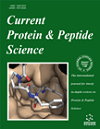- Home
- A-Z Publications
- Current Protein and Peptide Science
- Previous Issues
- Volume 17, Issue 4, 2016
Current Protein and Peptide Science - Volume 17, Issue 4, 2016
Volume 17, Issue 4, 2016
-
-
Neurotrophin Propeptides: Biological Functions and Molecular Mechanisms
More LessAuthors: Lola M. Rafieva and Eugene V. GasanovNeurotrophins constitute a family of growth factors that play a key role in the regulation of the development and function of the central and peripheral nervous systems. A common feature of all the neurotrophins is their synthesis in cells as long precursors (pre-pro-neurotrophins) that contain an N-terminal signal peptide, a following propeptide and the mature neurotrophin. Although the signal peptide functions have be Read More
-
-
-
Structural and Functional Characterization of the Proteins Responsible for N6-Methyladenosine Modification and Recognition
More LessAuthors: Ke Liu, Yumin Ding, Weiyuan Ye, Yanli Liu, Jihong Yang, Jinlin Liu and Chao QiRNA modification, involving in a wide variety of cellular processes, has been identified over 100 types since 1950s. N6-methyladenosine (m6A), as one of the most abundant RNA modifications, is found in several RNA species and predominantly located in the stop codons, long internal exons as well as 3’UTR. It was reported that m6A modification preferentially appears after G in the conserved motif RRm6ACH (R = A/G and H = Read More
-
-
-
Reversible and Irreversible Aggregation of Proteins from the FET Family: Influence of Repeats in Protein Chain on Its Aggregation Capacity
More LessThe discovery of protein chain regions responsible for protein aggregation is an important result of studying of the molecular mechanisms of prion diseases and different proteinopathies associated with the formation of pathological aggregations through the prion mechanism. The ability to control aggregation of proteins could be an important tool in the arsenal of the drug development. Here we demonstrate, on an exampl Read More
-
-
-
Pivotal Role of Mitogen-Activated Protein Kinase-Activated Protein Kinase 2 in Inflammatory Pulmonary Diseases
More LessAuthors: Feng Qian, Jing Deng, Gang Wang, Richard D. Ye and John W. ChristmanMitogen-activated protein kinase (MAPK)-activated protein kinase (MK2) is exclusively regulated by p38 MAPK in vivo. Upon activation of p38 MAPK, MK2 binds with p38 MAPK, leading to phosphorylation of TTP, Hsp27, Akt, and Cdc25 that are involved in regulation of various essential cellular functions. In this review, we discuss current knowledge about molecular mechanisms of MK2 in regulation of TNF-α production, NADPH Read More
-
-
-
Regulation of Runx2 by Histone Deacetylases in Bone
More LessOsteogenesis involves a cascade of processes wherein mesenchymal stem cells differentiate towards osteoblasts, strictly controlled by a number of regulatory factors. Runx2 protein is a key transcription factor which serves as a master regulator for osteogenesis by activating the promoters of various osteoblastic genes. Runx2 is regulated by several cofactors, including the histone deacetylase enzymes known as HDACs. HDACs Read More
-
-
-
Disorder in Milk Proteins: α -Lactalbumin. Part A. Structural Properties and Conformational Behavior
More LessThis is a first part of the two-part article that continues a series of reviews on the abundance and roles of intrinsic disorder in milk proteins. We introduce here α-lactalbumin, a small (Mr 14 200), simple, acidic (pI 4–5), Ca2+-binding protein that might constitute up to 20% of total milk protein. Although function (it is one of the two components of lactose synthase that catalyzes the final step of the lactose biosynthesis in Read More
-
-
-
Disorder in Milk Proteins: Formation, Structure, Function, Isolation and Applications of Casein Phosphopeptides
More LessThis article is a continuation of a series of reviews on the presence and the role of intrinsic disorder in milk proteins in the journal of Current Protein and Peptide Science. The focus of this article is on casein phosphopeptides, which are liberated during digestion of the milk protein casein. Structurally these phosphopeptides have multiphosphorylated regions making them highly charged. The high degree of charge coupled Read More
-
-
-
The Physio-Pharmacological Role of the NPS/NPSR System in Psychiatric Disorders: A Translational Overview
More LessBy Pasha GhazalIn 2004, Neuropeptide S (NPS) was identified to be the cognate ligand of the previously discovered orphan receptor GPCR 154, now termed as NPS receptor (NPSR). Since, then a wealth of data has elucidated the unique behavioral profile of this peptidergic system in numerous physiological function such as being pro-arousal and anxiolytic at the same time. Besides, its robust anxiolytic profile, this peptide system has been fo Read More
-
Volumes & issues
-
Volume 26 (2025)
-
Volume 25 (2024)
-
Volume 24 (2023)
-
Volume 23 (2022)
-
Volume 22 (2021)
-
Volume 21 (2020)
-
Volume 20 (2019)
-
Volume 19 (2018)
-
Volume 18 (2017)
-
Volume 17 (2016)
-
Volume 16 (2015)
-
Volume 15 (2014)
-
Volume 14 (2013)
-
Volume 13 (2012)
-
Volume 12 (2011)
-
Volume 11 (2010)
-
Volume 10 (2009)
-
Volume 9 (2008)
-
Volume 8 (2007)
-
Volume 7 (2006)
-
Volume 6 (2005)
-
Volume 5 (2004)
-
Volume 4 (2003)
-
Volume 3 (2002)
-
Volume 2 (2001)
-
Volume 1 (2000)
Most Read This Month
Article
content/journals/cpps
Journal
10
5
false
en


